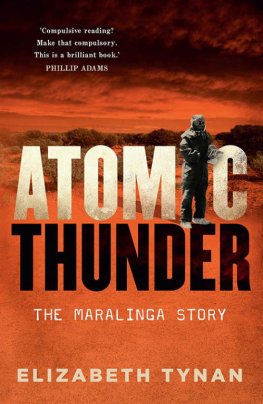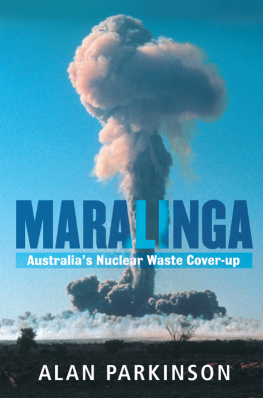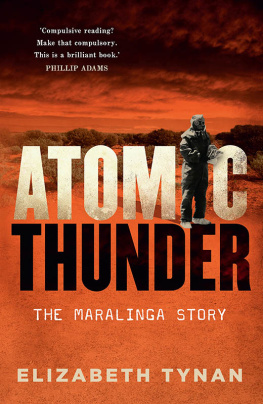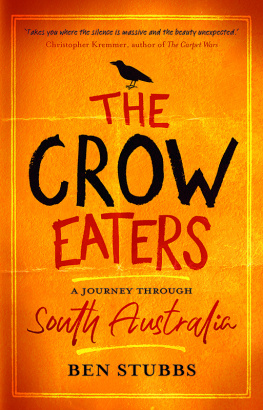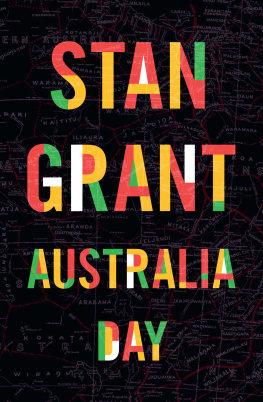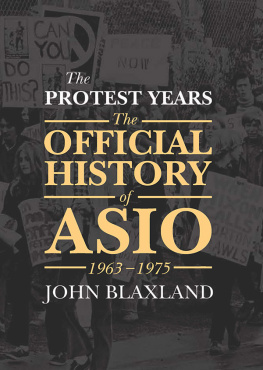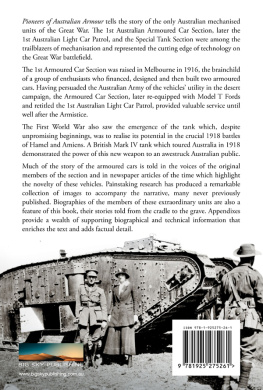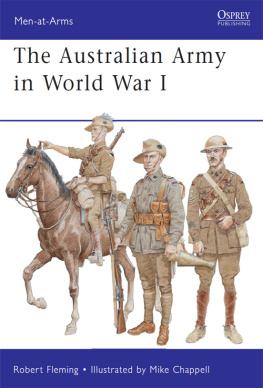Elizabeth Tynan
ATOMIC THUNDER
THE MARALINGA STORY
To the future.
May it learn something from the past.
As a bookish introvert, I enjoy nothing more than the challenge of living inside a big writing project. I have lived inside this one for quite a while. I havent been entirely on my own, though. In fact, without the magnificent contribution of a number of people, there would be no book. I hasten to add that while I have been greatly assisted by some excellent individuals, if there are any errors in this book they are mine alone.
My incomparable mother, Rosemary Jennings, has been central to the creation of this book. Her experience as a history researcher, including work for the Australian Dictionary of Biography, honed her acute historical brain and great love of history. She is also naturally pedantic and has directed this superpower onto my work. She has picked up errors that I have not been able to see, and she has been a sounding board for my ideas. She is one of the few people who will allow me to talk at length about Maralinga without suddenly remembering that she has to be somewhere else. I am grateful to have been able to do that, because sometimes the ideas just want to come out, and having someone willing to receive them has been inexpressibly important to me.
I would also like to thank radiation scientists and Maralinga experts Dr Geoff Williams and Mr Peter Burns. My visit to Geoff and Peter at the Australian Radiation Protection and Nuclear Safety Authority in Melbourne in 2004 planted the seed of an idea that later became my PhD thesis and still later became this book. I never knew that the Maralinga story was so rich and fascinating and terrible until I spent those crucial, life-changing hours in the presence of such knowledgeable scientists. Both Geoff and Peter have been kind enough to read parts of the manuscript to check for factual accuracy. Geoff also introduced me to Graeme Newgreen, who worked at Maralinga during the tests, and Graeme kindly read part of the text too.
Paul Malone was one of the intrepid investigative journalists who took on th Maralinga story when it became an important media event in the 1980s. His work with Howard Conkey at the Canberra Times revealed a complex story that he worked meticulously to uncover. He has generously given me access to his extensive archive of original documents relating to the nuclear tests in Australia, and I have drawn upon them gratefully and at length.
One of Australias best journalists, Brian Toohey, broke the story about plutonium contamination in a series of stories in the Financial Review in 1978. He kindly answered my questions about his Maralinga reporting when I put them to him while researching my PhD. I have quoted those answers in this book as well, to help provide some insights into the era of uncovering that he did so much to initiate. I acknowledge the considerable contribution of the late Ian Anderson, a science journalist of great talent and influence who was taken too soon. His work in the early 1990s in uncovering the true extent of plutonium contamination caused by Vixen B at Maralinga was an object lesson in why investigative journalism is essential in a democracy. I was privileged to work with him briefly at New Scientist; he taught me so much. His widow, Dr Robin Anderson, generously gave me access to parts of Ians personal archive in the early stages of my PhD research.
I gratefully acknowledge my employer, James Cook University. Part of the work involved in this book was carried out during a period of study leave in 2014. I particularly acknowledge the dean of graduate studies, Distinguished Professor Helene Marsh, who has always shown heartening and much-appreciated confidence in my abilities. Thank you also to linguists extraordinaire Professor Alexandra Aikhenvald and Professor Robert Dixon at James Cook University, who did the detective work that tracked down the origin of the word Maralinga.
This book had its genesis in the work I did for my doctorate. I would like to thank and acknowledge my supervisor at the Australian National University (ANU), Professor Sue Stocklmayer, and also Dr Will J Grant, both at the National Centre for the Public Awareness of Science. My PhD was a life-changing experience, and I thank them for their role in it.
My dear friend Susan Davies, who lives in New York and has been away for so long, will always be close to my heart. There truly is no friend like ones oldest friend. I am fortunate all-round in the quality of my friends. Special mentions to Melissa Lyne, Nicola Goc, George Roberts, Nadine Marshall, Marilyn Chalkley and Annie Warburton, who have all in a multitude of ways enriched my life.
My family is kind, loving and supportive, and I care for them deeply. With gratitude and love, I thank Dad (Frank), Inta, Meredith, Andrew, Narelle, Sophie and Alexander. As a long-time ANU employee, Dad knew some of the key players in this story and was able to share some tales. Also, my grandfather, Dads dad, worked for a while with Len Beadell, and Dad has helped me source material about Beadells exploits. I also thank my wider family my delightful aunts, uncles and cousins and mention in particular my dear Uncle Glen, who has always taken a keen interest in my Maralinga research. Thanks also to Brett.
An important marker of a robust democracy is ready access to a nations documents. I have made extensive use of the National Archives of Australia and the National Archives of the United Kingdom and have always found the experience rewarding and, indeed, rather exciting. Theres nothing like a set of old documents to get the blood racing. Sincere thanks to the staff at both archives for assisting me so ably.
I am indebted to Phillipa McGuinness at NewSouth Publishing, who saw promise in the Maralinga story and decided to take a chance on me. Thanks also to the always friendly and efficient Emma Driver, who has helped guide me through the process of becoming a NewSouth author. The term eagle-eyed barely begins to cover the talents of the editor Victoria Chance, who has been dogged and meticulous in editing this manuscript. Her highly professional work has made a huge difference to the quality of the final product. Thanks also to the proofreader Penny Mansley and the indexer Trevor Matthews, who have carried out their detailed work with admirable diligence.
I cant imagine life without the various animals who have filled my heart. I mention in particular Higgy, Minnie, Palmee, Samira, Ramona, Adelaide, Elvis, Lukey, Fred and Agnes. My heart still aches for those no longer with me, in particular Monty, Ava, Miranda, Bobby, Lily, Rosie, Wilfred and Wilma.
The Maralinga story is a vast, sprawling saga. This book is an attempt to provide a concise overview that will be of interest to the general reader, as well as offering a fresh perspective based upon years of analysis of the many diverse forms of evidence available. Many people have a profound stake in the events at all three test sites, most especially Indigenous people and service personnel (the nuclear veterans). My book does not seek to delve into the fine detail of the grievances of either of these groups, not because their grievances are irrelevant or uninteresting, but simply because to do so would make this a different book altogether. I have instead sought to broaden the view to show Maralinga in its historical and scientific context. What an honour it is to write such a story.
ABC Australian Broadcasting Commission (from 1983, Corporation)
AERE Atomic Energy Research Establishment (UK)
AIRAC Australian Ionising Radiation Advisory Council
ALP Australian Labor Party
ANU Australian National University

